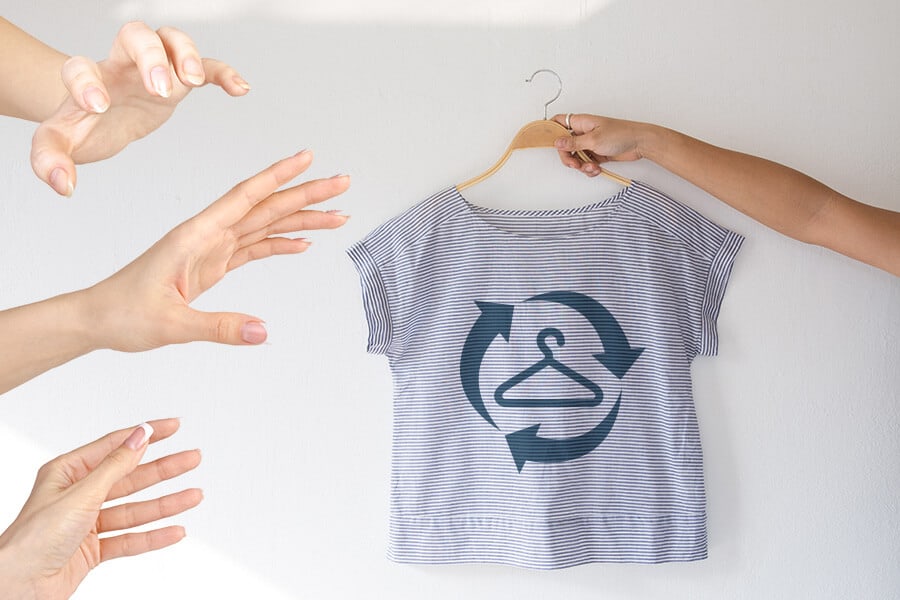In the ‘90s, thrift shopping was associated mostly with hipsters, and was seen as an option that came with the growing popularity of grunge music bands (cough, Nirvana). This sort of fashion movement was considered an anti-fashion statement because it did not follow any particular fashion trends, and its purpose was not to make your clothes look expensive or new. But we can easily say that nowadays thrift shopping has actually become a fashion trend itself.
Most Instagram fashion influencers have some amazing accounts, where they share clothes from the most famous thrift shops worldwide. Some wear them because they look cool, whereas others do it because they believe in environmental causes and long term climate change. Whatever the scenario, Millennials and Generation Z are among the age groups that have embraced the trend to thrift shopping and have done so 2.5 times faster than Baby Boomers or Generation X, as confirmed by the ThredUP website.
This is of course great news, as it appears that our level of consciousness is rising. Specifically, after 2010, people had their eyes on the fashion industry for its notoriety respecting the unethical treatment of workers, extended working hours, and unsafe working conditions. The way we shop has grown to be a global concern, making famous brands such as H&M or Gap provide more transparency regarding their supply chain.
But that’s not the only reason consumers have turned to thrift shopping. Gen Z and Gen Y are evidently more preoccupied with climate change, at least compared to the older generations. According to “The State of Fashion 2019” report conducted by McKinsey, “Nine in ten Generation Z consumers believe companies have a responsibility to address environmental and social issues.” Their report also emphasizes the need for companies to take an active stance on social issues, satisfy consumer demands for radical transparency and sustainability, and, most important, have the courage to “self-disrupt” their own identity and the sources of their former success to realize these changes and win new generations of customers.
And it’s not like some companies with famous brands worn by celebrities and promoted all over social media have not taken any action to improve their Corporate Social Responsibility (CSR) policies. For instance, Everlane devotes a #BlackFridayFund to a socially responsible organization every year. In 2018, the company furthered its efforts to reduce plastic waste by partnering with Surfrider, an organization dedicated to protecting coastlines and removing plastic from the oceans. And the mission statement at Reformation proclaims that the brand is committed to minimizing its environmental impact and achieving fair, safe, and healthy working conditions throughout their supply chain.
However, the problem is that although these brands are sustainable and ethical, they are often much pricier than their fast-fashion counterparts. Here come thrift stores to save the day, to provide ethical clothing for consumers who do not possess the resources to buy from fancy brands.
Why is Thrifting good?

You’ve probably heard people say that Thrifting is not only good for your wallet, but it’s also good for the planet. Thrifting means recycling, and you are being way nicer to the environment if you reduce the level of waste and pollution that already exists by simply not throwing away clothes but giving them a second chance. It is easy if you think about the size of the carbon footprint it takes to produce your clothes – the natural resources used to create the fabric, make the clothing, and actually ship it to its final destination.
Except for that, by thrift shopping you are also doing a favour to so many people who work in dangerous and exhausting conditions to produce the clothes you wear. And they are mostly women, children, displaced persons, or impoverished people who are easier to exploit because they can work in any sort of conditions as long as they have a little money as a reward and food to feed their loved ones.
And of course, they say that shopping is a reflection of the shopper’s own identity. If consumers worldwide are not buying second-hand clothes for sustainable and ethical reasons, they are doing it because they feel unique while they are buying one-of-a-kind clothes. Thrift shops usually do this for them, as they have unique, old pieces which can be combined perfectly at such an affordable price, and which make the consumer look like the most vintage, artsy human being there is. Who wouldn’t want to be portrayed like this? And this is why we have so many influencers who are relying on second-hand stores to “make their personalities a bit cooler”, if we may say, because that is just the truth. Famous brands are becoming too mainstream, something everyone finds and wears easily. Each of us is seeking to “stand out from the crowd”. That’s why you have to be very creative and think when you shop second-hand. It’s not easy at all to pull out something old and make it look unique on you, reflecting the mysterious history behind the clothing. But it’s this thrill and the chance of expressing your creativity that makes thrift shops the place to be.
Is it good for everyone that thrift shopping has become more popular?

We have noted how great it is that the level of awareness about ethical consumption is rising, and with this, the number of people who choose thrift. But remember, until not long ago, second hand shopping was something people looked down upon. It meant that you belonged to the working class or the poor and did not have the means to go ahead and buy everything that’s on sale. Since Thrifting is all of a sudden in, and has become a trend even for wealthy consumers, this means that the prices at second-hand stores will keep rising, reducing the narrowed options of low-income communities. That is why it’s up to consumers to take a stand, and start to become conscious even to this extent. In the name of eco-consciousness, we should also be very much cautious towards our fellow human beings who have a harder time making ends meet by the end of the month.
Photos: Shutterstock / Photomontages: Martina Advaney
Read more on the topic of sustainability and fashion!
Support us!
All your donations will be used to pay the magazine’s journalists and to support the ongoing costs of maintaining the site.
Share this post
Interested in co-operating with us?
We are open to co-operation from writers and businesses alike. You can reach us on our email at cooperations@youthtimemag.com/magazine@youthtimemag.com and we will get back to you as quick as we can.









